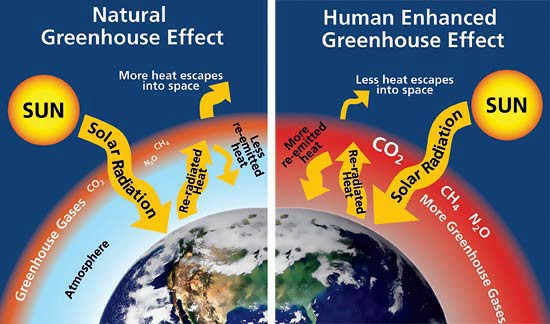
Greenhouse effect and global heating
What is the greenhouse effect?
A body heated by a heat source, like a saucepan on a stove, does not stay hot for long if the heat source is turned off. The heat disperses in the environment. Our planet is also heated where it is day and loses heat where it is night.
The greenhouse effect is a natural phenomenon involving the retention of solar heat at the Earth’s surface before it is dispersed. This is done by greenhouse gases in the atmosphere that act as a barrier, letting solar radiation in but preventing it from being dispersed.
Types of greenhouse effect: natural and man made
The greenhouse effect is therefore a natural phenomenon, fundamental for life on our planet. If there were no greenhouse gases in the atmosphere, the mean global temperature would prevent water from existing in liquid phase on the Earth, and there would also be enormous differences in temperature between day and night on all parts of the global surface. Increasing or decreasing the amount of greenhouse gases in the atmosphere therefore means greatly changing the mean temperature in all parts of the world.
In the past, the concentrations of the greenhouse gases composing our atmosphere varied naturally and gradually over millions of years, between warm or temperate geological eras and intervening ice ages.
Today, however, atmospheric concentrations of greenhouse gases are changing very fast due to human activities. The speed at which they are increasing and the high concentrations reached have alarmed scientists. Never have humans lived on the Earth with such high levels of greenhouse gases and never has the planet undergone such rapid changes. What does the future hold for life on the planet?
What causes the greenhouse effect?
The greenhouse effect is a natural phenomenon but the rapid increase in atmospheric concentrations of greenhouse gases has man-made causes. These include human activities that release enormous quantities of greenhouse gases to the atmosphere by burning fossil fuels (coal, oil, methane) to produce energy, but also for example the chemical industry that produces plastics, and even intensive livestock farming for meat, dairy and other animal products.
Practically every human activity today releases greenhouse gases, the most common of which is carbon dioxide. Until only a few centuries ago, our activities did not violate the natural cycles of atmospheric emission and fixation by photosynthesis of plants. With the industrial revolution of the 19th century, combustion, especially of coal, began to upset the balance with nature. Explosion of the human population, combustion of fossil fuels and indiscriminate felling of forests upset natural equilibria in little over a century.
Is there a relation between the greenhouse effect and the hole in the ozone layer?
Unlike greenhouse gases, ozone is a gas that forms an atmospheric layer for many physical reasons related to its chemical composition. The creatures of the Earth are beholden to this layer for absorbing much ultraviolet sunlight, which would otherwise damage their DNA and give rise to tumours.
Although the greenhouse effect and the hole in the ozone layer have parallel histories, they are two distinct phenomena. The “hole” is not actually a hole, hollow or tear, because the layer is not solid. The term “hole” is a simplification to describe a thinning of the layer, observed by scientists in the 1970s. The cause was release to atmosphere of chlorinated gases known as chlorofluorocarbons (CFCs) commonly used as propellents in spray cans and as refrigerants in refrigerators. When these gases rise to the ozonosphere, they destroy ozone molecules, letting in ultraviolet radiation, harmful to life. For the first time in history, a man-made cause of a problem of planetary interest was identified (CFCs do not exist in nature).
Chlorofluorocarbons were banned by the Montreal Protocol in 1987, and after many years we can now say that the hole in the ozone layer is reducing. According to current trends, the hole should be closed by 2050.


